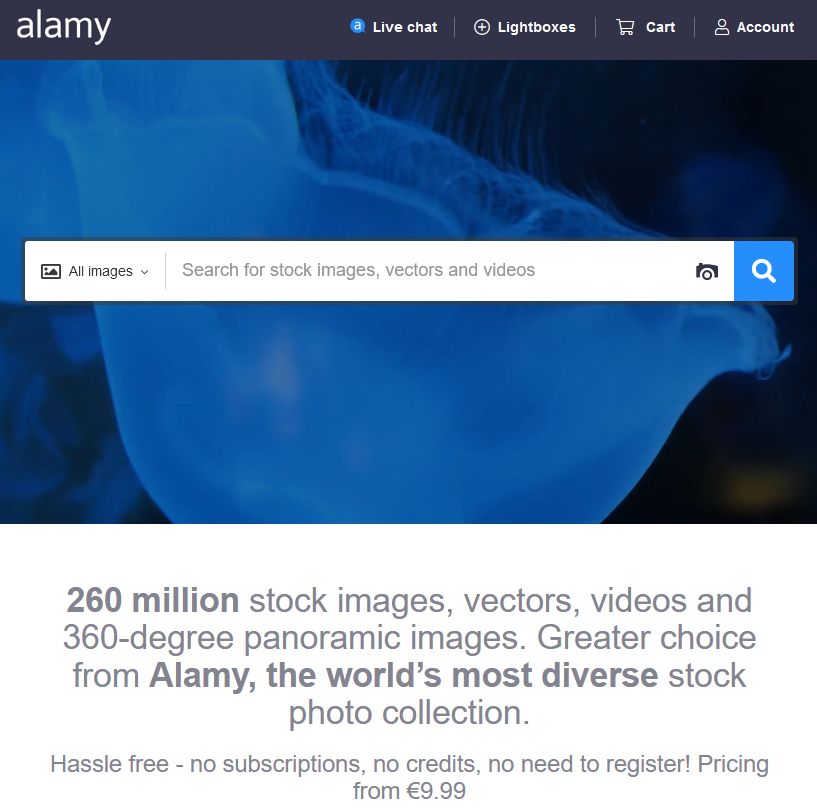Alamy has carved a unique place in the world of stock photography, offering an extensive collection of images that cater to a wide range of needs. Whether you are a professional designer, a blogger, or someone looking to spice up a presentation, Alamy provides over 215 million images at your fingertips. But how does one navigate this treasure trove? Let's explore
One of the standout features of Alamy is its commitment to diversity. With contributions from photographers and artists worldwide, their library includes everything from stunning landscapes to candid moments in everyday life. Each image is meticulously categorized, making it easier for you to find exactly what you're looking for without sifting through endless options.
Another appealing aspect is the flexibility in licensing. Alamy offers various licensing options to accommodate different use cases, from personal projects to commercial campaigns. This flexibility allows you to select images that fit your specific requirements without worrying about violating any licensing agreements.
Moreover, the platform's user-friendly interface ensures a smooth experience, allowing you to search, filter, and choose images effortlessly. Whether you're trying to capture the essence of a particular event or wanting to elevate your social media posts, Alamy's vast library is both an invaluable resource and a compelling inspiration source.
Understanding Copyright and Licensing Terms

When diving into the world of stock photography, it’s paramount to grasp the concepts of copyright and licensing. So what does this all mean? Let’s break it down in a simple way.
Copyright is a legal term that grants the creator of an original work exclusive rights to its use and distribution. This means that if you download an image from Alamy, you can't just use it freely as you wish without understanding the licensing terms associated with that image. Violating these terms could lead to serious legal troubles.
Alamy typically offers two main types of licenses:
- Royalty-Free (RF): This allows you to use the image multiple times without paying additional royalties, but you can't claim ownership of the image. Perfect for ongoing projects!
- Rights Managed (RM): This license is more restrictive. The price is determined based on how you plan to use the image, its duration, and its geographical reach. Think of it as a tailored license that can cater to your specific needs.
In addition, some images may come with specific restrictions, such as:
| Restriction Type | Description |
|---|---|
| Editorial Use Only | Cannot be used for commercial purposes or promotional materials. |
| Attribution Required | Must credit the creator of the image when used. |
| Non-Transferable | License is only valid for the original purchaser and cannot be shared. |
Understanding these terms is essential. Always make sure to read the specific licensing details for each image you wish to use. Clarity on these matters not only protects you legally but also supports the talented photographers and artists who contribute to platforms like Alamy.
Also Read This: Making Money from Alamy Images: Exploring Revenue Opportunities
3. Types of Licenses Offered by Alamy

When you’re diving into the world of stock photography, understanding the different types of licenses is crucial, especially with a platform like Alamy. Alamy offers a variety of licenses catering to diverse needs. Let’s break them down:
- Royalty-Free License: This is one of the most common forms of licensing. With this option, you can pay a one-time fee to use an image for various purposes without worrying about additional royalties. However, there may be restrictions on the number of copies or geographic distribution, so it’s wise to check the specifics.
- Rights Managed License: This type of license is a bit more complex. Here, the usage rights are negotiated directly with the photographer or agent. Usage fees depend on several factors, including the duration of use, the medium, and the audience size. It can be perfect for specific projects where you want to ensure exclusive rights.
- Extended License: If the standard rights don’t quite cut it for your needs, an extended license might be perfect. This allows for broader usage scenarios, like merchandise or high-volume print runs. Basically, it's a way to expand your creative options.
Choosing the right license can save you headaches down the line, so always feel free to reach out to Alamy’s support team if you're unsure which option fits your project best!
Also Read This: Maximize Your Creative Projects with Alamy’s Image Library
4. How to Use Alamy Images Legally

Using images from Alamy legally is easier than you might think! Following a few simple guidelines can save you from the hassle of copyright issues. Here’s what you need to keep in mind:
- Understand Licensing Terms: Before you download any image, make sure you read and understand the licensing terms that come with it. Each license has its own rules about how and where you can use the images.
- Attribute When Required: Some licenses require that you credit the photographer. Looking for phrases like “must be credited” in your licensing agreement helps you stay compliant.
- Use Images Within Licensed Limits: Stick to the usage limits outlined in your license. For instance, if your license allows for only online use, avoid printing the image unless the license specifies otherwise.
- Stay Updated on Changes: Occasionally, licensing rules may change. Keep an eye on any communications from Alamy regarding updates to their policies.
By following these straightforward steps, you can enjoy Alamy's vast collection of images while respecting the rights of the photographers. Happy image hunting!
Also Read This: Top LinkedIn Video Downloader Extensions in 2023
Common Misconceptions About Alamy and Copyright
When it comes to using images from Alamy, misunderstandings about copyright can lead to some pretty big headaches. Let’s clarify some of the most common misconceptions:
- Misconception 1: All Alamy Images are Free to Use - While Alamy does offer a variety of pricing options, it's important to note that most images come with a license fee. These fees help support the photographers and creators who contribute to the platform. So, don't assume all images are free; always check the price and licensing terms.
- Misconception 2: Purchasing an Image Means You Own It - Buying an image from Alamy does not mean you own the copyright outright. Instead, you gain specific rights to use the image according to the licensing agreement. This is a crucial distinction! Read the fine print to understand your rights.
- Misconception 3: You Can Use Alamy Images for Any Purpose - Not all licenses cover every type of usage. Some images may be restricted to non-commercial use only, while others may permit commercial use with certain conditions. Always ensure your intended usage aligns with the license granted.
- Misconception 4: Alamy Images Don’t Need Attribution - Even when you have a license, there may be requirements for attribution. Remember, respecting the work of creators goes a long way. Always check if you need to credit the photographer.
It’s easy to see how these misconceptions can lead to legal issues down the line. So, always do your research and familiarize yourself with the rules surrounding the images you wish to use!
Conclusion and Best Practices for Using Alamy Images
In wrapping up, using Alamy images can be a breeze if you know what to look for. So, let’s highlight some best practices to ensure you’re on the right track:
- Read Licensing Agreements Closely: Before you download or purchase any image, carefully review the licensing terms to understand what’s allowed and what’s not.
- Consider Your Intended Use: Whether it's for a blog post, promotional material, or social media, choose an image that fits your needs and matches the applicable license.
- Always Attribute When Required: If the licensing terms state that you need to credit the photographer, make sure to do so. This not only respects the creator but also adds credibility to your work.
- Keep Records: Maintain a record of the images you use and their corresponding licenses. This could prove invaluable if questions about usage arise later.
- Stay Updated: Copyright laws and licensing agreements can change, so check back on Alamy and stay informed about any updates that might affect your use of their images.
By following these best practices, you can enjoy the rich visual content Alamy offers while minimizing the risk of copyright issues. Remember, respecting copyright is not just about legality; it's about honoring the creativity and effort of the artists behind the images!
 admin
admin








